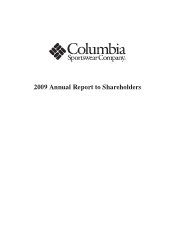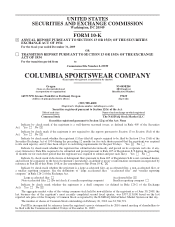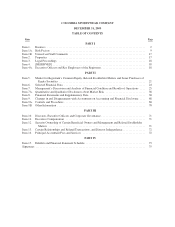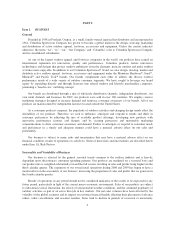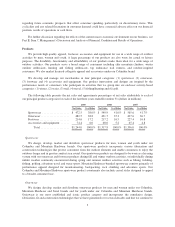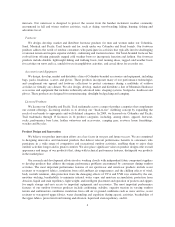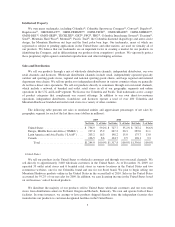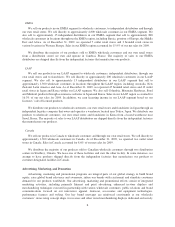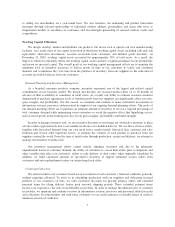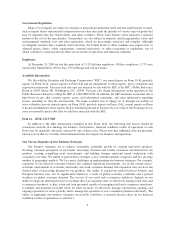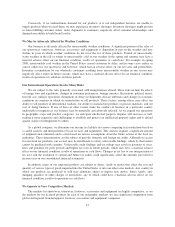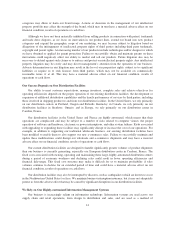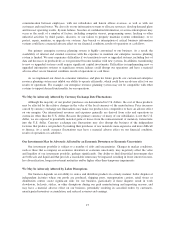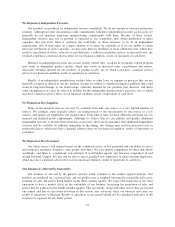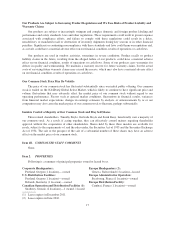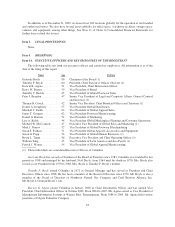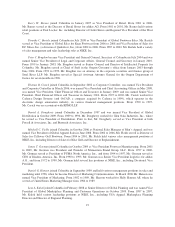Columbia Sportswear 2009 Annual Report Download - page 16
Download and view the complete annual report
Please find page 16 of the 2009 Columbia Sportswear annual report below. You can navigate through the pages in the report by either clicking on the pages listed below, or by using the keyword search tool below to find specific information within the annual report.Government Regulation
Many of our imports are subject to existing or potential governmental tariff and non-tariff barriers to trade,
such as import duties and potential safeguard measures that may limit the quantity of various types of goods that
may be imported into the United States and other countries. These trade barriers often represent a material
portion of the cost of the merchandise. Our products are also subject to domestic and foreign product safety and
environmental standards, laws and other regulations, which are increasingly restrictive and complex. Although
we diligently monitor these standards and restrictions, the United States or other countries may impose new or
adjusted quotas, duties, safety requirements, material restrictions, or other restrictions or regulations, any of
which could have a material adverse effect on our results of operations and financial condition.
Employees
At December 31, 2009 we had the equivalent of 3,113 full-time employees. Of these employees, 1,773 were
based in the United States, 835 in Asia, 359 in Europe and 146 in Canada.
Available Information
We file with the Securities and Exchange Commission (“SEC”) our annual report on Form 10-K, quarterly
reports on Form 10-Q, current reports on Form 8-K and all amendments to those reports, proxy statements and
registration statements. You may read and copy any material we file with the SEC at the SEC’s Public Reference
Room at 100 F Street, NE, Washington, D.C. 20549. You may also obtain information on the operation of the
Public Reference Room by calling the SEC at 1-800-SEC-0330. In addition, the SEC maintains an internet site at
http://www.sec.gov that contains reports, proxy and information statements, and other information regarding
issuers, including us, that file electronically. We make available free of charge on or through our website at
www.columbia.com our annual reports on Form 10-K, quarterly reports on Form 10-Q, current reports on Form
8-K and amendments to these reports filed or furnished pursuant to Section 13(a) or 15(d) of the Exchange Act as
soon as reasonably practicable after we file these materials with the SEC.
Item 1A. RISK FACTORS
In addition to the other information contained in this Form 10-K, the following risk factors should be
considered carefully in evaluating our business. Our business, financial condition, results of operations or cash
flows may be materially adversely affected by any of these risks. Please note that additional risks not presently
known to us or that we currently deem immaterial may also impair our business and operations.
Our Success Depends on Our Business Strategies
Our business strategies are to achieve sustainable, profitable growth by creating innovative products,
elevating consumer perception of our brands, increasing consumer and retailer awareness and demand for our
products, creating compelling retail environments, and building stronger emotional brand connections with
consumers over time. We intend to pursue these strategies across extended product categories and in a growing
number of geographic markets. We face many challenges in implementing our business strategies. For example,
expansion of our direct-to-consumer business has required significant investments, yet, in the current macro-
economic environment of economic uncertainty and weak consumer demand, this expansion may not have the
desired effect of increasing demand for our products. Our ability to expand our global footwear business and
European business may also be significantly limited as a result of global economic conditions and a general
weakness in global consumer demand. The success of our retail and e-commerce initiatives depends on our
ability to adapt our internal processes to facilitate direct-to-consumer sales, to effectively manage retail store and
e-commerce inventory, to hire, retain and train personnel capable of managing retail and e-commerce operations,
to identify and negotiate favorable terms for retail locations, to effectively manage construction, opening, and
ongoing operations of stores globally and to manage the operation of our e-commerce platform effectively. The
failure to implement our business strategies successfully could have a material adverse effect on our financial
condition, results of operations or cash flows.
9


